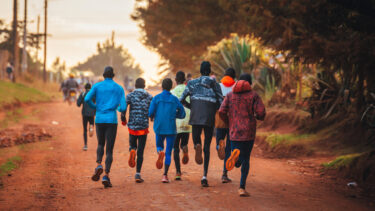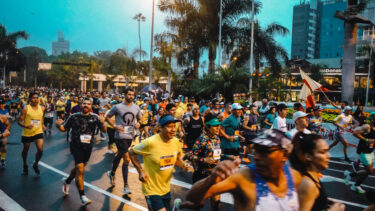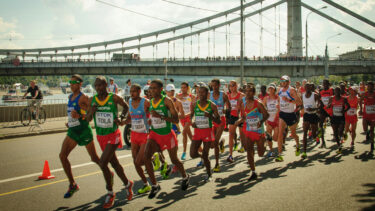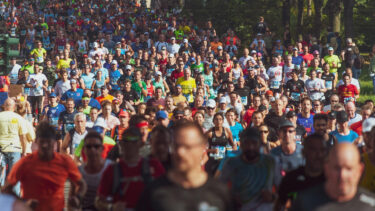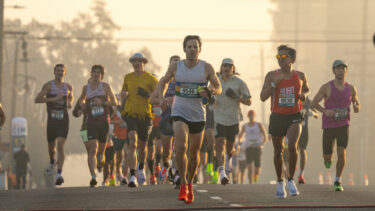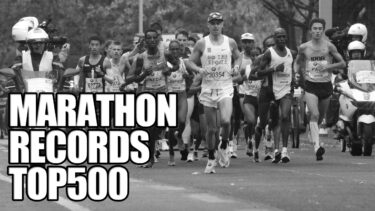Ever run a marathon and wondered, “Is this really 42.195 km?” The truth is, the distances of the marathon courses we run are measured with an astonishing level of precision and strictness. Especially for international competitions where world records are set, courses must be “certified” by World Athletics (formerly IAAF) under rigorous rules.
So, how exactly do they measure such a long course? Let’s uncover the secrets!

The Gold Standard: The “Calibrated Bicycle Method” with a Jones Counter
The most reliable and widely used method for measuring marathon course distances is the “Calibrated Bicycle Method.” This isn’t just a casual bike ride; it’s an incredibly meticulous process.
- The Secret Weapon: The Jones Counter:
A specially calibrated bicycle is fitted with a unique device called a “Jones Counter” on its wheel. This counter precisely records the distance by clicking as the bicycle moves, measuring with incredible accuracy. - Meticulous Calibration is Key:
They don’t just start measuring the course right away. First, the bicycle is repeatedly ridden back and forth over a known, perfectly flat, and straight “calibration section” (usually 500m or 1000m). This process precisely adjusts the Jones Counter to match the actual distance. They even account for factors like temperature and tire pressure! - Tracing the “Tangent Shortest Route” (TSR)!:
Once calibrated, it’s time to measure the actual course. The measurement follows the “Tangent Shortest Route (TSR),” which is the shortest possible line a runner would realistically take on the course.- The Basic Idea: Measurements are taken approximately 30cm from the edge of the road (curb or pavement). This accounts for the fact that runners typically stay slightly away from the very edge.
- Navigating Curves:
- Left Turns: The measurement follows a line 30cm in from the inside edge of the curve (the sidewalk side).
- Right Turns: If there’s a center line, it’s measured 30cm inside from that line (the inside of the curve). If there’s no center line, the shortest line 30cm in from the assumed inside edge of the road width is used.
- S-Curves: The bike “cuts” the corners of the S-curve to follow the absolute shortest possible line.
- So, instead of measuring down the middle of the road, the process constantly anticipates the shortest, most efficient line a runner would take. Measuring down the middle would lead to significant inaccuracies, especially on curves!
- Multiple Measurements for Zero Error:
Typically, this bicycle measurement is performed three or more times, and the average value is used as the official course distance. This helps eliminate even the slightest potential for error.
Other Measurement Methods Play Supporting Roles!
While the Jones Counter bicycle method is the primary technique, other measurement methods also exist, though they mainly serve auxiliary roles.
- GPS (Global Positioning System):
GPS devices, like those in your running watch, can estimate distances. However, their accuracy can decrease in urban areas with tall buildings, tunnels, or dense forests. Therefore, GPS is mainly used for reference or for estimating distances during training. - Map Measurement / Geographic Information Systems (GIS):
High-precision map data can be used to calculate course distances. This is useful for the initial planning stages of a course or for getting a rough estimate of the distance. However, map data can’t perfectly reflect road undulations or subtle curves, so on-site physical measurement remains crucial for official certification. - Steel Tape Measure:
This method is extremely accurate but impractical for measuring an entire marathon course. It’s primarily used for precise calibration of the Jones Counter or for measuring very short sections, such as the exact distance from the start line to the first turn. Since steel tape expands and contracts with temperature, adjustments are made for that too!
“Certified Courses” – A Mark of Trust!
For a marathon course to be recognized as “certified,” it must meet strict requirements set by World Athletics:
- Expert Measurers: “International Certified Measurers,” who have undergone specialized training and are experts in using the Jones Counter and determining the TSR, conduct the measurements.
- Independent Measurement: The measurers must be independent of the event organizers to ensure fairness and impartiality.
- Issuance of Certificate: Once all measurements are complete, a certificate is issued by World Athletics, guaranteeing the course’s official distance. This ensures that runners worldwide can trust the course and their records.
Conclusion: Records are Forged on “Accurate Distances”!
Measuring a marathon course distance is much more than just figuring out its length. It’s a vital process that ensures fair competition and validates runners’ hard-earned records. Especially for international events, the “Calibrated Bicycle Method with a Jones Counter” is indispensable.
Knowing the meticulous effort behind the courses we run makes marathon running even more fascinating, doesn’t it?
Perhaps the marathon course in your own city was measured using this very method!


